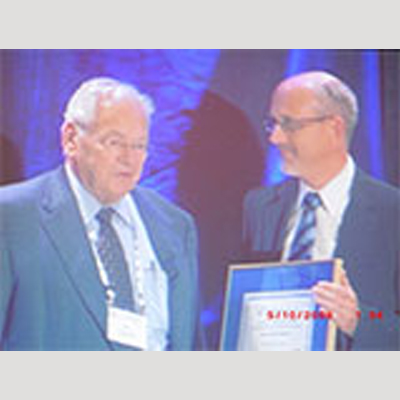This year IATDMCT celebrates the 25th anniversary of its founding meeting in Barcelona, Spain on October 11, 1990. To highlight this important event the editors of the Compass invited Dr. Charles Pippenger, one of the founders of our association and name giver of the IATDMCT C.E. Pippenger Award presented for outstanding contributions to Therapeutic Drug Monitoring, to be our next mentor for the “IATDMCT mentors interview” column. And we are more than honored that he agreed…
Enjoy reading!
Photo: Montreal 2009, Dr. Pippenger presents Pierre Marquet the C.E. Pippenger Award for outstanding contributions to TDM
Compass: This year IATDMCT celebrates its 25th anniversary and you were one of the founders. How was the idea born to establish this new association?
Dr. Pippenger: Prior to the founding of IATDMCT, we were a loosely knit group of individuals all interested in TDM or CT. Each of us was fighting to get the discipline recognized by our peers. We decided by working together we could exert more influence to support our peers, to assure TDM’s quality and move TDM/CT into the 21st. century.
Compass: What is your personal experience with IATDMCT over the years and does the development meet your expectations?
Dr. Pippenger: My experience with IATDMCT over the years has been most rewarding. One of the reasons for forming the organization was to allow the young people a chance to play an active role in the development of the discipline and keep it going long after the founders were no longer active. That’s exactly what happened. I’m so proud of the people who followed behind us.
Compass: What advice do you have for young people wanting to get involved in the further development of IATDMCT?
Dr. Pippenger: I would urge every young scientist interested in any aspect of TDM or CT to take a very active role in the organization. It not only provides a platform where you can exchange ideas with your peers; it also advocates for you as a group or individual to accomplish things which would be difficult to accomplish by yourself. I would also remind you that you have to advocate for every patient to receive appropriate TDM services; no one else will.
Compass: What were in your opinion the most important development in the fields of TDM and CT during the last 25 years?
Dr. Pippenger: I believe the two most important advances have been the evolution of pharmacogenomics/pharmacogenetics and the enhanced improvement and simplicity of LC/MSMS allows it to be applicable and utilized in many more laboratories than it has been in the past. We hear how bright the future is and pharmacogenetics will allow us to “personalize” patient therapy. We were describing TDM as a means of individualizing (personalizing) patient drug therapy throughout the 1970s. (TDM 1979 1:1) The truth is pharmacogenetics only measures genotype which generalizes about a patient’s ability to utilize drugs (metabolism too fast, too slow etc.). The only way you can utilize genotype to individualize a patient’s therapeutic regimen is by combining the information with the patient’s quantitative drug concentrations in real time; in other words, TDM allows phenotyping of a patient rather than genotyping. You can’t accurately adjust therapeutic regimens with genotypes; you need the patient’s phenotype.
Compass: What are your predictions for advances in TDM/CT over the next 25 years?
Dr. Pippenger: Hopefully, close collaboration between pharmacogenetics and TDM disciplines. This is entirely dependent upon the willingness of individuals in both groups to recognize the importance of the other and work together to achieve our common goal. The pharmacogeneticists will NOT readily come to IATDMCT. We need to reach out to them and force the issue. We will see a return to bedside testing for both TDM and CT as better micro methods are developed. I dream someday patients with various types of cancer will actually be treated utilizing TDM and pharmacogenetics rather than by the antiquated standard algorithms/doses we use today. We know it can be done! Dr. Bill Evans, et.al. proved it with Acute Lymphocytic Leukemia (Hon and Evans 1998, Clinical Chemistry 44:2 388–400; Pui and Evans, N Engl J Med 2006;354:166;). They increased ALL survival from 50 to 80% using only TDM. Still today, we make more people sick, ensure a lousy quality of life and often an early death because we don’t optimize their treatment regimens from the beginning. This must change. IATDMCT can cause change to happen rapidly. We must educate clinicians and the lay public. Talking without action is useless.
The content of the IATDMCT Blog does not necessarily have the endorsement of the Association.



